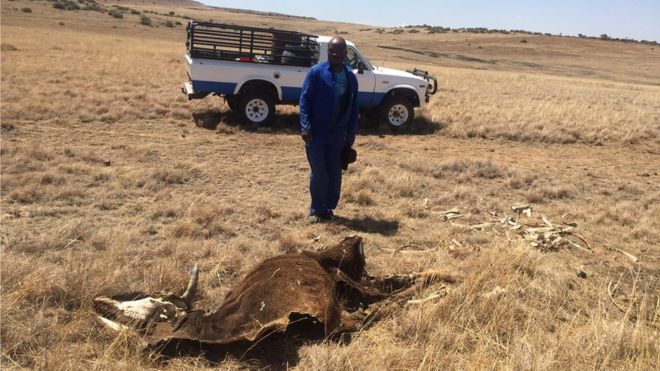Slow Violence
By Bonolo Mokwele Meso
Violence is often defined as "the intentional use of physical force of power , threatened or actual ,against oneself, another person or against a group or community,which either result in or has a high likelihood resulting in injury , death , psychological harm , underdevelopment or deprivation" [World health organisation 2004] . However Rob Nixon redefines the term violence in his book Slow Violence And The Environmentalism of The Poor. In this book Nixon writes pragmatically about the difficulties in fighting what he calls " spectacle deficient" environmental crises like climate change , compromised ecosystems and toxic waste whose victims are spread over time and place; these processes , Nixon says are , slow violence . Pervasive , devastating and unnoticed. This blog will take the form of a picture essay and air pollution will be the violator of concern, on will seek to use images that could perhaps increase the public's awareness on slow violence.
Just as slow violence is made invisible by its subtle pace and scattered impacts, its victims themselves are invisible, at least in the tiny and shifting lens of the world media. These are microminorities , the marginalized women in already marginalized society ; often slow violence occurs in the "passive voice ' , the suffering is a shame of course but it comes as a side effect rather than through the immediate action from any responsible party , leaving a trail of excuses and denial. Who is responsible or rather whose fault is it when a child goes hungry ? whose fault is it when leukemia clusters come 10 years later after and a hundred miles away from disaster ? I don't know but what I can say is that " slow violence is not a class blind concept . it is mostly the poor who are most vulnerable to the slow violence of malnutrition and environmental pollution, they often struggle alone as atomized individuals.

Perpetrator 1 = Power Plants

Perpetrator 2 = Air Transportation

Perpetrator 3 = Car Fumes

Perpetrator 4 = Human Activity
Smog hanging over cities is the most familiar and more obvious form of " slow violence", the more obvious from of air pollution some visible and some invisible that contribute to global warming. Generally any substance that people the( perpetrators of violence) throw into the atmosphere that has damaging effects on living things and the environment is considered air pollution.
Carbon dioxide , a greenhouse gas , is considered to be largely the main pollutant that is warming the earth. Though living species/ things emit carbon dioxide when they breath, carbon dioxide is widely considered to be a pollutant when associated with cars , planes, power plants, and other human activities as seen in the pictures above. In the past 150 years such activities have pumped enough carbon dioxide into the atmosphere to raise its levels higher than they have been for hundreds of thousand of years.

WHY DO YOU INSIST ON HURTING ME WHEN ALL I'VE DONE THROUGH OUT THE YEARS IS LOVE YOU ?
Personal Narrative on slow violence.
When we have cut up all the roots to her trees,
When we have hunted all her animals,
When all the air she gives is unsafe to breathe only then will we realise we can not eat money , yes money the paper we can not eat it in the literal sense. We can no longer suck from her breast and expect nourishment because perhaps we would have commodified her breasts too.
Mother earth and all of her children have a built desire to keep things in balance and harmony . Over the years though, we her children have seriously upset that balance; all we continue to do is destroy forests to make more farming land, erect buildings for the sole purpose of making a profit, more people equal to more food. The same holds true for oceans. More humans need more, houses,cars, clothes, television sets, internet gadgets and other material possessions typically accumulated over a lifetime. It is a vicious cycle that is destroying our planet.
Mother earth is starting to fight back , she does not like being out of balance , quite frankly she can no longer endure all the abuse, enough is enough. She is fighting back because her children's arrogance and selfishness have gotten out of control. We see this with the violent weather patterns, global warming, increasing volcano activity, excessive rain and snow, rising sea levels, plague like conditions,etc are all warring signs that our Mother is highly upset. She is crying because all she has ever done is provide us with love and nourishment from hear breasts like an ordinary mother would to her child.But, because of greed and money we have become separated from our source of life which has resulted to our self-centeredness. This self-centeredness will lead to our demise sooner than we think if we do not make things right with our Mother.
In concluding '' Slow Violence" is inspiring , innovative to an extent and passionate, Nixon forces us to confront some of the most urgent issues facing the continued existence of humans on the planet , He re-energizes environmental literature , infusing the filed with the transitional concerns of world literature ,and creatively reinvigorates post colonial studies.
Sources Consulted
Nixon, R. 2011. Slow violence and the environmentalism of the poor. Cambridge: Harvard University Press.
Khallat, MK. 2011. The Impact of air pollution on health , economy , environment and agriculture. CCBY-NC SA 3.0 license, @ The Authors.
[environment.nationalgeographic.com/envirionment/global-warming/pollution overview]
accessed 22 April 2016
[www.who.ink/violenceprevention/approach/definition/en/]
The violence that goes unnoticed. Blair Braverman April 4 , 2012 ]
accessed 22 April 2016 .
By Bonolo Mokwele Meso














